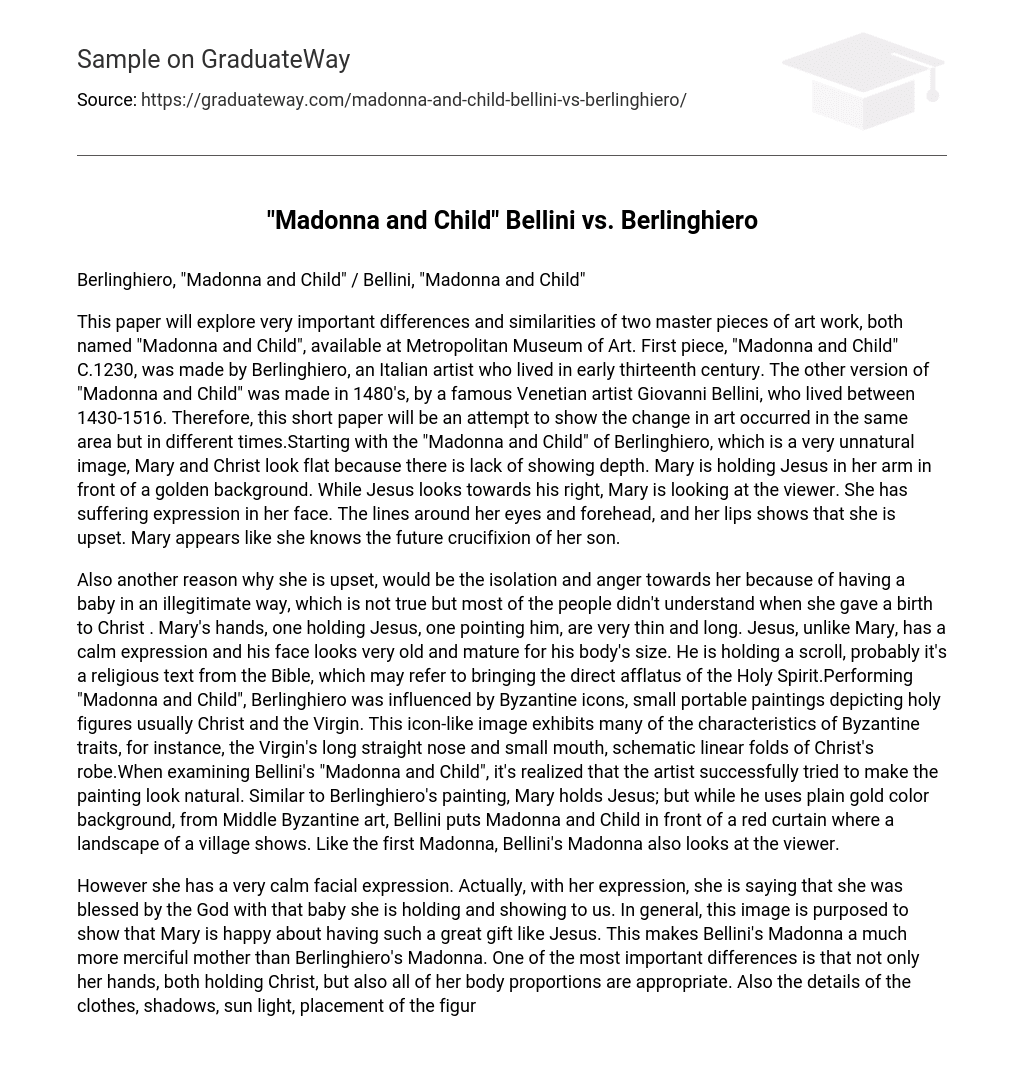Berlinghiero, “Madonna and Child” / Bellini, “Madonna and Child”
This paper will explore very important differences and similarities of two master pieces of art work, both named “Madonna and Child”, available at Metropolitan Museum of Art. First piece, “Madonna and Child” C.1230, was made by Berlinghiero, an Italian artist who lived in early thirteenth century. The other version of “Madonna and Child” was made in 1480’s, by a famous Venetian artist Giovanni Bellini, who lived between 1430-1516. Therefore, this short paper will be an attempt to show the change in art occurred in the same area but in different times.Starting with the “Madonna and Child” of Berlinghiero, which is a very unnatural image, Mary and Christ look flat because there is lack of showing depth. Mary is holding Jesus in her arm in front of a golden background. While Jesus looks towards his right, Mary is looking at the viewer. She has suffering expression in her face. The lines around her eyes and forehead, and her lips shows that she is upset. Mary appears like she knows the future crucifixion of her son.
Also another reason why she is upset, would be the isolation and anger towards her because of having a baby in an illegitimate way, which is not true but most of the people didn’t understand when she gave a birth to Christ . Mary’s hands, one holding Jesus, one pointing him, are very thin and long. Jesus, unlike Mary, has a calm expression and his face looks very old and mature for his body’s size. He is holding a scroll, probably it’s a religious text from the Bible, which may refer to bringing the direct afflatus of the Holy Spirit.Performing “Madonna and Child”, Berlinghiero was influenced by Byzantine icons, small portable paintings depicting holy figures usually Christ and the Virgin. This icon-like image exhibits many of the characteristics of Byzantine traits, for instance, the Virgin’s long straight nose and small mouth, schematic linear folds of Christ’s robe.When examining Bellini’s “Madonna and Child”, it’s realized that the artist successfully tried to make the painting look natural. Similar to Berlinghiero’s painting, Mary holds Jesus; but while he uses plain gold color background, from Middle Byzantine art, Bellini puts Madonna and Child in front of a red curtain where a landscape of a village shows. Like the first Madonna, Bellini’s Madonna also looks at the viewer.
However she has a very calm facial expression. Actually, with her expression, she is saying that she was blessed by the God with that baby she is holding and showing to us. In general, this image is purposed to show that Mary is happy about having such a great gift like Jesus. This makes Bellini’s Madonna a much more merciful mother than Berlinghiero’s Madonna. One of the most important differences is that not only her hands, both holding Christ, but also all of her body proportions are appropriate. Also the details of the clothes, shadows, sun light, placement of the figures are done very successfully. Thus, comparing to Berlinghiero’s work, this one is much more realistic. Bellini’s Jesus, again with a calm facial expression, is showed as a baby. He is looking up, probably to the heavens and maybe to his father, the Holy Spirit, from his mother’s lap. In one hand baby Christ is holding a pear, instead of a scroll, and the other hand is on his hearth. In addition, baby Christ is nude while mature Child wears a robe. Performing “Madonna and Child”, Bellini was influenced by the traits of that time, when is beginning of the Renaissance. This oil painting pursues a naturalistic approach to representation based on observation, with providing realistic light-shadow, successful perspective, depth, natural folds of Mary’s clothes and appropriate body proportions.In conclusion, these two pieces of art very different from each other in terms of style, material, feelings. The major differences between the two are naturalism, one looks like a three-dimensional photo and one is almost cartoon-like, and deep emotions, sadness vs. peace.





